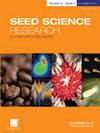使用种子呼吸作为计算“农场”大麦种子灌浆最佳浸泡时间的工具(Hordeum vulgare)
IF 2.1
3区 生物学
Q2 PLANT SCIENCES
引用次数: 5
摘要
摘要一种名为“农场”种子引发的低成本技术越来越被认为是最大限度地提高作物产量的有效方法。它包括在播种前将种子厌氧浸泡在水中,从而快速均匀地发芽,并增强幼苗活力。这些好处的程度取决于浸泡时间。目前通过发芽试验和小型小区试验确定最佳浸泡时间是资源密集型的,因为它是物种/基因型特异性的。本研究旨在确定大麦启动过程中种子呼吸速率(代谢活性的指标)和种子形态变化的潜力,作为启动效益的预测因素,从而有助于确定最佳浸泡时间。一系列发芽测试表明,发芽率主要归因于胚胎组织的快速水合,因为发芽率的最高提高发生在呼吸恢复之前。然而,直到种子启动至少8小时,也就是第一次呼吸爆发后,发芽均匀性才显著改善。当在胚胎轴分化开始前(20小时)停止启动时,幼苗活力达到最大,之后活力开始下降(“过度启动”)。胚胎轴伸长的开始之前是第二次呼吸爆发,这可以用作启动优化的标志。因此,对种子呼吸的监测为当前的实践提供了一种快速且廉价的替代方案。该方法可以由农业机构实施,为特定地区的普通大麦品种提供推荐的最佳浸泡时间。本文章由计算机程序翻译,如有差异,请以英文原文为准。
Using seed respiration as a tool for calculating optimal soaking times for ‘on-farm’ seed priming of barley (Hordeum vulgare)
Abstract A low-cost technique named ‘on-farm’ seed priming is increasingly being recognized as an effective approach to maximize crop establishment. It consists of anaerobically soaking seeds in water before sowing resulting in rapid and uniform germination, and enhanced seedling vigour. The extent of these benefits depends on the soaking time. The current determination of optimal soaking time by germination assays and mini-plot trials is resource-intensive, as it is species/genotype-specific. This study aimed to determine the potential of the seed respiration rate (an indicator of metabolic activity) and seed morphological changes during barley priming as predictors of the priming benefits and, thus, facilitate the determination of optimal soaking times. A series of germination tests revealed that the germination rate is mostly attributable to the rapid hydration of embryo tissues, as the highest gains in the germination rate occurred before the resumption of respiration. Germination uniformity, however, was not significantly improved until seeds were primed for at least 8 h, that is, after a first respiration burst was initiated. The maximum seedling vigour was attained when the priming was stopped just before the beginning of the differentiation of embryonic axes (20 h) after which vigour began to decrease (‘over-priming’). The onset of embryonic axis elongation was preceded by a second respiration burst, which can be used as a marker for priming optimization. Thus, monitoring of seed respiration provides a rapid and inexpensive alternative to the current practice. The method could be carried out by agricultural institutions to provide recommended optimal soaking times for the common barley varieties within a specific region.
求助全文
通过发布文献求助,成功后即可免费获取论文全文。
去求助
来源期刊

Seed Science Research
生物-植物科学
CiteScore
3.60
自引率
4.80%
发文量
23
审稿时长
>12 weeks
期刊介绍:
Seed Science Research, the official journal of the International Society for Seed Science, is a leading international journal featuring high-quality original papers and review articles on the fundamental aspects of seed science, reviewed by internationally distinguished editors. The emphasis is on the physiology, biochemistry, molecular biology and ecology of seeds.
 求助内容:
求助内容: 应助结果提醒方式:
应助结果提醒方式:


